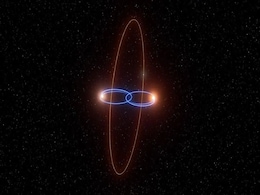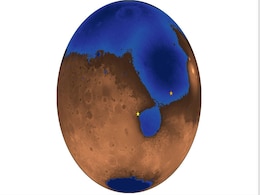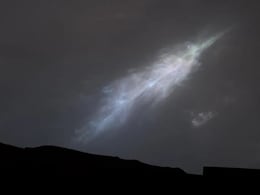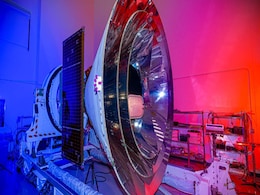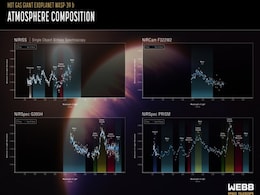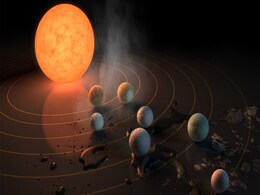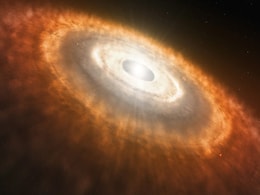Planet Formation
- All
- News
-

Bizzare 'Failed Star' Planet Orbiting Double Star System in Milky Way Discovered by Researchers
- Thursday April 17, 2025
- Written by Gadgets 360 Staff
Astronomers have discovered an exoplanet 90 degrees tilted around a special pair of eclipsing brown dwarfs. This uncommon "polar planet" challenges accepted wisdom on planet creation by presenting new insights on the dynamics of binary stars and the range of Milky Way planetary orbits.
-
 www.gadgets360.com
www.gadgets360.com
-

JWST Captures Unseen Details of Exoplanets in HR 8799 and 51 Eridani Systems
- Thursday April 3, 2025
- Written by Gadgets 360 Staff
The James Webb Space Telescope (JWST) has captured groundbreaking images of exoplanets in the HR 8799 and 51 Eridani systems. By modifying its coronagraphs, astronomers allowed more starlight to pass through, revealing clearer planetary details. The study, published in The Astrophysical Journal Letters, highlights the first successful detection of ...
-
 www.gadgets360.com
www.gadgets360.com
-

NASA's Webb Captures First Direct Images Of Carbon Dioxide Outside Solar System
- Tuesday March 18, 2025
- Science | Edited by Ritu Singh
This finding provides compelling evidence that the giant planets in HR 8799 formed through core accretion, a process similar to the formation of Jupiter and Saturn.
-
 www.ndtv.com
www.ndtv.com
-

Mysterious Planetary-Mass Objects May Form in Young Star System Clashes
- Wednesday March 12, 2025
- Written by Gadgets 360 Staff
Recent research challenges traditional views on planetary-mass objects, suggesting they may form through violent interactions between young star systems rather than standard planetary or stellar processes. Simulations indicate these clashes create dense gas filaments that evolve into free-floating objects, often in binary pairs. This discovery expl...
-
 www.gadgets360.com
www.gadgets360.com
-

Primordial Helium-3 May Be Locked in Earth’s Core, Study Finds
- Wednesday March 5, 2025
- Written by Gadgets 360 Staff
Helium-3, an isotope formed during the solar system's birth, may be trapped in Earth's core, a study suggests. Researchers at the University of Tokyo found that helium can mix with iron at extreme heat and pressure, allowing it to remain in Earth's solid core. This discovery could help determine how quickly the planet formed, with a rapid formation...
-
 www.gadgets360.com
www.gadgets360.com
-

Ancient Martian Ocean Shoreline Discovered Beneath Surface by Zhurong Rover
- Monday March 3, 2025
- Written by Gadgets 360 Staff
China's Zhurong rover has uncovered evidence of an ancient ocean on Mars, with ground-penetrating radar detecting a buried shoreline beneath the Utopia Basin. The rover’s scans revealed sloping sand layers similar to those found on Earth’s beaches, reinforcing theories of long-term water presence. Experts highlight that these formations are not...
-
 www.gadgets360.com
www.gadgets360.com
-

Hubble Captures Stunning Tarantula Nebula Image, Revealing Cosmic Dust and Star Formation
- Thursday February 27, 2025
- Written by Gadgets 360 Staff
A new image from the Hubble Space Telescope highlights the Tarantula Nebula’s complex structure, featuring dense cosmic dust clouds and vibrant star-forming regions. This nebula, located 160,000 light-years away, plays a vital role in understanding stellar evolution. The captured details offer insights into how cosmic dust contributes to star and...
-
 www.gadgets360.com
www.gadgets360.com
-

Hubble’s New Image of Tarantula Nebula Showcases Cosmic Dust and Star Formation
- Tuesday February 18, 2025
- Written by Gadgets 360 Staff
NASA/ESA’s Hubble Space Telescope has captured a breathtaking image of the Tarantula Nebula, located 160,000 light-years away in the Large Magellanic Cloud. The image reveals intricate cosmic dust patterns and active star formation, offering valuable insights into the role of interstellar material in stellar evolution. Researchers are using the d...
-
 www.gadgets360.com
www.gadgets360.com
-

NASA’s Curiosity Rover Captures Stunning Feather-Shaped Iridescent Cloud on Mars
- Friday February 14, 2025
- Written by Gadgets 360 Staff
A remarkable feather-shaped iridescent cloud was spotted by NASA’s Curiosity rover on Mars. Captured during a seasonal imaging campaign, this phenomenon provides valuable data on Martian weather patterns. Scientists believe such clouds help study particle sizes and atmospheric changes. The cloud, composed of either water ice or carbon dioxide ice...
-
 www.gadgets360.com
www.gadgets360.com
-

JWST Unveils HH 30’s Protoplanetary Disk, Showing Dust Grains and Jets
- Monday February 10, 2025
- Written by Gadgets 360 Staff
The James Webb Space Telescope has captured an extraordinary image of HH 30, a protoplanetary disk in the Taurus constellation. The dense dust disk conceals the central star, while bright jets extend outward, interacting with surrounding gas. Microscopic dust grains within the disk have been identified, playing a crucial role in planetary formation...
-
 www.gadgets360.com
www.gadgets360.com
-

NASA SPHEREx Telescope to Map the Universe and Search for Life’s Ingredients
- Thursday January 30, 2025
- Written by Gadgets 360 Staff
NASA’s SPHEREx mission, set to launch aboard a SpaceX Falcon 9 rocket on February 27, aims to explore the origins of the universe and the formation of galaxies. Using near-infrared light, the telescope will study over 450 million galaxies and 100 million stars in the Milky Way. It will also search for water and organic molecules in regions where ...
-
 www.gadgets360.com
www.gadgets360.com
-

Astronomers Discover Water and Carbon Dioxide in WASP-166 b's Atmosphere
- Saturday January 11, 2025
- Written by Gadgets 360 Staff
Astronomers have detected water and carbon dioxide in the atmosphere of WASP-166 b, a hot super-Neptune exoplanet. Using data from the James Webb Space Telescope (JWST), the findings also noted ammonia in smaller quantities. WASP-166 b, located 368 light-years away, is a massive planet that orbits its star every 5.44 days, with a temperature of 1,2...
-
 www.gadgets360.com
www.gadgets360.com
-

Organic Molecules in Space: A Key to Understanding Life's Cosmic Origins
- Saturday December 28, 2024
- Written by Gadgets 360 Staff
Organic molecules, the building blocks of life, have been discovered across space—from interstellar clouds to asteroids and comets. Findings from missions like Rosetta, Hayabusa2, and Osiris-Rex reveal that these compounds existed long before the Sun formed. Scientists believe organic molecules survived planetary formation in protoplanetary disks...
-
 www.gadgets360.com
www.gadgets360.com
-

Researchers Unveil New Theory on the Formation of Jupiter-Mass Binary Objects
- Thursday December 26, 2024
- Written by Gadgets 360 Staff
A team of researchers has proposed a new theory explaining the formation of Jupiter-mass binary objects (JuMBOs), identified in 2023 in the Orion Nebula. The theory involves photo erosion, where radiation from massive stars strips away mass from stellar cores, shaping JuMBOs into objects with masses comparable to Jupiter. This theory sheds light on...
-
 www.gadgets360.com
www.gadgets360.com
-

New Study Challenges Planet Formation Models with PDS 70b’s Chemical Mystery
- Thursday December 19, 2024
- Written by Gadgets 360 Staff
A new study on PDS 70b, a forming exoplanet located 400 light-years away, reveals a significant mismatch between its atmospheric composition and the surrounding protoplanetary disk. This discovery casts doubt on existing planet formation models, suggesting that more research is needed to understand how planets gather materials and elements during t...
-
 www.gadgets360.com
www.gadgets360.com
-

Bizzare 'Failed Star' Planet Orbiting Double Star System in Milky Way Discovered by Researchers
- Thursday April 17, 2025
- Written by Gadgets 360 Staff
Astronomers have discovered an exoplanet 90 degrees tilted around a special pair of eclipsing brown dwarfs. This uncommon "polar planet" challenges accepted wisdom on planet creation by presenting new insights on the dynamics of binary stars and the range of Milky Way planetary orbits.
-
 www.gadgets360.com
www.gadgets360.com
-

JWST Captures Unseen Details of Exoplanets in HR 8799 and 51 Eridani Systems
- Thursday April 3, 2025
- Written by Gadgets 360 Staff
The James Webb Space Telescope (JWST) has captured groundbreaking images of exoplanets in the HR 8799 and 51 Eridani systems. By modifying its coronagraphs, astronomers allowed more starlight to pass through, revealing clearer planetary details. The study, published in The Astrophysical Journal Letters, highlights the first successful detection of ...
-
 www.gadgets360.com
www.gadgets360.com
-

NASA's Webb Captures First Direct Images Of Carbon Dioxide Outside Solar System
- Tuesday March 18, 2025
- Science | Edited by Ritu Singh
This finding provides compelling evidence that the giant planets in HR 8799 formed through core accretion, a process similar to the formation of Jupiter and Saturn.
-
 www.ndtv.com
www.ndtv.com
-

Mysterious Planetary-Mass Objects May Form in Young Star System Clashes
- Wednesday March 12, 2025
- Written by Gadgets 360 Staff
Recent research challenges traditional views on planetary-mass objects, suggesting they may form through violent interactions between young star systems rather than standard planetary or stellar processes. Simulations indicate these clashes create dense gas filaments that evolve into free-floating objects, often in binary pairs. This discovery expl...
-
 www.gadgets360.com
www.gadgets360.com
-

Primordial Helium-3 May Be Locked in Earth’s Core, Study Finds
- Wednesday March 5, 2025
- Written by Gadgets 360 Staff
Helium-3, an isotope formed during the solar system's birth, may be trapped in Earth's core, a study suggests. Researchers at the University of Tokyo found that helium can mix with iron at extreme heat and pressure, allowing it to remain in Earth's solid core. This discovery could help determine how quickly the planet formed, with a rapid formation...
-
 www.gadgets360.com
www.gadgets360.com
-

Ancient Martian Ocean Shoreline Discovered Beneath Surface by Zhurong Rover
- Monday March 3, 2025
- Written by Gadgets 360 Staff
China's Zhurong rover has uncovered evidence of an ancient ocean on Mars, with ground-penetrating radar detecting a buried shoreline beneath the Utopia Basin. The rover’s scans revealed sloping sand layers similar to those found on Earth’s beaches, reinforcing theories of long-term water presence. Experts highlight that these formations are not...
-
 www.gadgets360.com
www.gadgets360.com
-

Hubble Captures Stunning Tarantula Nebula Image, Revealing Cosmic Dust and Star Formation
- Thursday February 27, 2025
- Written by Gadgets 360 Staff
A new image from the Hubble Space Telescope highlights the Tarantula Nebula’s complex structure, featuring dense cosmic dust clouds and vibrant star-forming regions. This nebula, located 160,000 light-years away, plays a vital role in understanding stellar evolution. The captured details offer insights into how cosmic dust contributes to star and...
-
 www.gadgets360.com
www.gadgets360.com
-

Hubble’s New Image of Tarantula Nebula Showcases Cosmic Dust and Star Formation
- Tuesday February 18, 2025
- Written by Gadgets 360 Staff
NASA/ESA’s Hubble Space Telescope has captured a breathtaking image of the Tarantula Nebula, located 160,000 light-years away in the Large Magellanic Cloud. The image reveals intricate cosmic dust patterns and active star formation, offering valuable insights into the role of interstellar material in stellar evolution. Researchers are using the d...
-
 www.gadgets360.com
www.gadgets360.com
-

NASA’s Curiosity Rover Captures Stunning Feather-Shaped Iridescent Cloud on Mars
- Friday February 14, 2025
- Written by Gadgets 360 Staff
A remarkable feather-shaped iridescent cloud was spotted by NASA’s Curiosity rover on Mars. Captured during a seasonal imaging campaign, this phenomenon provides valuable data on Martian weather patterns. Scientists believe such clouds help study particle sizes and atmospheric changes. The cloud, composed of either water ice or carbon dioxide ice...
-
 www.gadgets360.com
www.gadgets360.com
-

JWST Unveils HH 30’s Protoplanetary Disk, Showing Dust Grains and Jets
- Monday February 10, 2025
- Written by Gadgets 360 Staff
The James Webb Space Telescope has captured an extraordinary image of HH 30, a protoplanetary disk in the Taurus constellation. The dense dust disk conceals the central star, while bright jets extend outward, interacting with surrounding gas. Microscopic dust grains within the disk have been identified, playing a crucial role in planetary formation...
-
 www.gadgets360.com
www.gadgets360.com
-

NASA SPHEREx Telescope to Map the Universe and Search for Life’s Ingredients
- Thursday January 30, 2025
- Written by Gadgets 360 Staff
NASA’s SPHEREx mission, set to launch aboard a SpaceX Falcon 9 rocket on February 27, aims to explore the origins of the universe and the formation of galaxies. Using near-infrared light, the telescope will study over 450 million galaxies and 100 million stars in the Milky Way. It will also search for water and organic molecules in regions where ...
-
 www.gadgets360.com
www.gadgets360.com
-

Astronomers Discover Water and Carbon Dioxide in WASP-166 b's Atmosphere
- Saturday January 11, 2025
- Written by Gadgets 360 Staff
Astronomers have detected water and carbon dioxide in the atmosphere of WASP-166 b, a hot super-Neptune exoplanet. Using data from the James Webb Space Telescope (JWST), the findings also noted ammonia in smaller quantities. WASP-166 b, located 368 light-years away, is a massive planet that orbits its star every 5.44 days, with a temperature of 1,2...
-
 www.gadgets360.com
www.gadgets360.com
-

Organic Molecules in Space: A Key to Understanding Life's Cosmic Origins
- Saturday December 28, 2024
- Written by Gadgets 360 Staff
Organic molecules, the building blocks of life, have been discovered across space—from interstellar clouds to asteroids and comets. Findings from missions like Rosetta, Hayabusa2, and Osiris-Rex reveal that these compounds existed long before the Sun formed. Scientists believe organic molecules survived planetary formation in protoplanetary disks...
-
 www.gadgets360.com
www.gadgets360.com
-

Researchers Unveil New Theory on the Formation of Jupiter-Mass Binary Objects
- Thursday December 26, 2024
- Written by Gadgets 360 Staff
A team of researchers has proposed a new theory explaining the formation of Jupiter-mass binary objects (JuMBOs), identified in 2023 in the Orion Nebula. The theory involves photo erosion, where radiation from massive stars strips away mass from stellar cores, shaping JuMBOs into objects with masses comparable to Jupiter. This theory sheds light on...
-
 www.gadgets360.com
www.gadgets360.com
-

New Study Challenges Planet Formation Models with PDS 70b’s Chemical Mystery
- Thursday December 19, 2024
- Written by Gadgets 360 Staff
A new study on PDS 70b, a forming exoplanet located 400 light-years away, reveals a significant mismatch between its atmospheric composition and the surrounding protoplanetary disk. This discovery casts doubt on existing planet formation models, suggesting that more research is needed to understand how planets gather materials and elements during t...
-
 www.gadgets360.com
www.gadgets360.com

